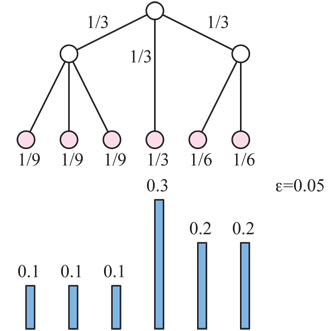I want to design a tree to approximate a given sequence of numbers, in the following sense. Let $X=(x_1,\ldots,x_n)$ be $n$ numbers, with $0 < x_i \le 1$ and $\sum_i x_1 = 1$. For a rooted tree $T$, imagine particles traveling from the root to the leaves, branching with equal probability at each junction. So, at a node with $k$ children, $1/k$ of the particles flow to each child. Each leaf then gets assigned the fraction of particles that will accummulate there, multiplying the probabilities at each node on the path from the root to that leaf.
Given $X$, I would like to design a tree $T$ that approximates
$X$ within $\epsilon$, meaning that the probabilities
at the leaves read left-to-right are each within $\pm \epsilon$
of the corresponding $x_i$.
For example, with
$X = ( 0.1, 0.1, 0.1, 0.3, 0.2, 0.2 )$ and $\epsilon=0.05$,
this tree suffices:

In particular, I would like to minimize the number of junctions in $T$:
Given $X$ and $\epsilon$, construct a tree $T$ with as few nodes as possible whose $n$ ordered leaf-probabilities are within $\epsilon$ of the $x_i$.
It feels like this should be polynomial-time rather than intractible, but I am not seeing a clear algorithm. It also feels like it might be a better-known problem in disguise... Any ideas?
(Motivation partially derives from an earlier MO question, Ping-pong relief map of a given function $z=f(x,y)$ Ping-pong relief map of a given function $z=f(x,y)$.)
